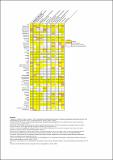Por favor, use este identificador para citar o enlazar a este item:
http://hdl.handle.net/10261/169777COMPARTIR / EXPORTAR:
 SHARE SHARE
 CORE
BASE CORE
BASE
|
|
| Visualizar otros formatos: MARC | Dublin Core | RDF | ORE | MODS | METS | DIDL | DATACITE | |

| Título: | Insights Into Sexual Maturation and Reproduction in the Norway Lobster (Nephrops norvegicus) via in Silico Prediction and Characterization of Neuropeptides and G Protein-coupled Receptors |
Autor: | Nguyen, Tuan V.; Rotllant, Guiomar CSIC ORCID CVN ; Cummins, Scott F.; Elizur, Abigail; Ventura, Tomer | Palabras clave: | Crustacea Data mining Neurohormone Neuropeptides Neuropeptidome GPCRs Phoenixin |
Fecha de publicación: | jul-2018 | Editor: | Frontiers Media | Citación: | Frontiers in Endocrinology | Resumen: | Multiple biological processes across development and reproduction are modulated by neuropeptides that are predominantly produced and secreted from an animal's central nervous system. In the past few years, advancement of next-generation sequencing technologies has enabled large-scale prediction of putative neuropeptide genes in multiple non-model species, including commercially important decapod crustaceans. In contrast, knowledge of the G protein-coupled receptors (GPCRs), through which neuropeptides act on target cells, is still very limited. In the current study, we have used in silico transcriptome analysis to elucidate genes encoding neuropeptides and GPCRs in the Norway lobster (Nephrops norvegicus), which is one of the most valuable crustaceans in Europe. Fifty-seven neuropeptide precursor-encoding transcripts were detected, including phoenixin, a vertebrate neurohormone that has not been detected in any invertebrate species prior to this study. Neuropeptide gene expression analysis of immature and mature female N. norvegicus, revealed that some reproduction-related neuropeptides are almost exclusively expressed in immature females. In addition, a total of 223 GPCR-encoding transcripts were identified, of which 116 encode GPCR-A (Rhodopsin), 44 encode GPCR-B (Secretin) and 63 encode other GPCRs. Our findings increase the molecular toolbox of neural signaling components in N. norvegicus, allowing for further advances in the fisheries/larvae culture of this species | Descripción: | 16 pages, 8 figures, supplementary material https://doi.org/10.3389/fendo.2018.00430 | Versión del editor: | https://doi.org/10.3389/fendo.2018.00430 | URI: | http://hdl.handle.net/10261/169777 | DOI: | 10.3389/fendo.2018.00430 | Identificadores: | doi: 10.3389/fendo.2018.00430 e-issn: 1664-2392 |
| Aparece en las colecciones: | (ICM) Artículos |
Ficheros en este ítem:
| Fichero | Descripción | Tamaño | Formato | |
|---|---|---|---|---|
| Nguyen_et_al_2018.pdf | 971,85 kB | Adobe PDF |  Visualizar/Abrir | |
| Nguyen_et_al_2018_suppl_1.docx | 16,67 kB | Microsoft Word XML | Visualizar/Abrir | |
| Nguyen_et_al_2018_suppl_2.pdf | 1,5 MB | Adobe PDF |  Visualizar/Abrir | |
| Nguyen_et_al_2018_suppl_3.xlsx | 106,03 kB | Microsoft Excel XML | Visualizar/Abrir | |
| Nguyen_et_al_2018_suppl_4.pdf | 70,24 kB | Adobe PDF |  Visualizar/Abrir | |
| Nguyen_et_al_2018_suppl_5.pdf | 802,86 kB | Adobe PDF |  Visualizar/Abrir | |
| Nguyen_et_al_2018_suppl_6.docx | 28,04 kB | Microsoft Word XML | Visualizar/Abrir | |
| Nguyen_et_al_2018_suppl_7.xlsx | 48,75 kB | Microsoft Excel XML | Visualizar/Abrir | |
| Nguyen_et_al_2018_suppl_8.pdf | 3,81 MB | Adobe PDF |  Visualizar/Abrir | |
| Nguyen_et_al_2018_suppl_9.docx | 17,74 kB | Microsoft Word XML | Visualizar/Abrir |
CORE Recommender
PubMed Central
Citations
21
checked on 17-abr-2024
SCOPUSTM
Citations
36
checked on 23-abr-2024
WEB OF SCIENCETM
Citations
29
checked on 26-feb-2024
Page view(s)
355
checked on 24-abr-2024
Download(s)
785
checked on 24-abr-2024

